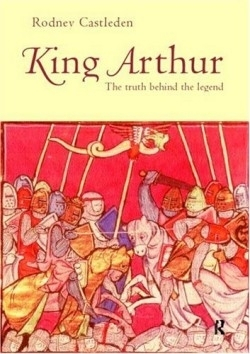King Arthur
The Truth Behind the Legend
The dark ages. A period in history that brings to mind kings, castles and dragons. A time in the period of history of England where the myth of Arthur was born. Castledon explores the evidence of sixth century England in an attempt to give reality to the historical Arthur. He prefaces his attempt in such a manner as to allow the reader to shape his own opinion after encountering all of the facts. Castledon concentrates on archaeology, documents and political history to present the facts about Arthur.
The main focus for archaeological evidence is Tintagel Island and South Cadbury Castle in Cornwall. Both of these sites have high concentrations of imported Mediterranean pottery. Imported pottery was considered valuable during this time when no coins were issued. Only eight sites have imported pottery linked to them and all are linked to Arthur.
Castledon concedes that little narrative text has survived the fifth and sixth centuries of England. Major sources that are cited are Nennius and Gildas. These give both the British side of history and the Anglo Saxon version. Of course one mentions Arthur and one does not. For explicit documentation he mentions two passages that speak of Arthur specifically. These from the Easter Annals inform the reader of an Arthur that was triumphant in battle, and secondly an Arthur that died in battle. Castledon is thorough in that he also mentions extensive documentation during this time that may corroborate the historical perspective of this time line. For further Dark Age documentation, Castledon refers the reader to John Morris’ The Age of Arthur as well as documents an extensive bibliography in this book.
During this time in history, England was undergoing great social and political change. The Romans had left. The Saxons were intent on invading. The native population was divided among vast kingdoms with feuding kings and sub kings. The author presents a thorough portrait of this political upheaval in an attempt to show Arthur as the rising king intent on uniting England as one country against the Saxon invaders.
For the novice historian, one is immersed in this survey of dates, places and names, which at times becomes daunting. For the follower of all that is Arthur, Castledon provides a comprehensive survey of the known data surrounding sixth century Britain. Facts are provided for the reader to make a sound individual judgement on whether or not Arthur existed.
Reviewed by
Norvilla Bennett
Disclosure: This article is not an endorsement, but a review. The publisher of this book provided free copies of the book to have their book reviewed by a professional reviewer. No fee was paid by the publisher for this review. Foreword Reviews only recommends books that we love. Foreword Magazine, Inc. is disclosing this in accordance with the Federal Trade Commission’s 16 CFR, Part 255.

